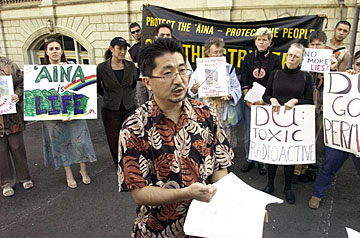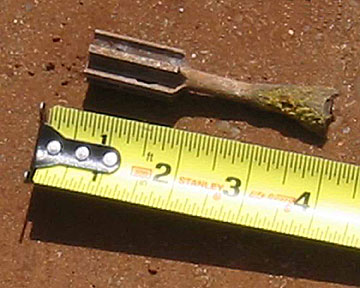皆様
今年も宜しくお願いいたします。
今日、転送されてきたハワイ発のニュースの抄訳です。
嘉指信雄(NO DU ヒロシマ・プロジェクト)
*****
アメリカ陸軍は欺いてきた―地元団体が非難
[劣化]ウランの発見に憤るハワイの活動家たち
「使用済み金属(=ウラン)がスコフィールド演習場に残っていることを示す陸軍の電子メールは遺憾」と識者が批判
記者:ローズマリー・ベルナルド
『ホノルル・スターブリテン』(2006年1月6日)
劣化ウランとして知られる重金属がスコフィールド・バラックス射爆場複合施設で発見されたことを受け、いくつかの環境団体や地元団体は、陸軍は市民を欺いてきたと非難している。
昨日(1月5日)の記者会見において、市民グループは、「陸軍は、こうした重金属(劣化ウラン)はハワイでは全く使用されていない、と市民に繰り返し保証してきた」と述べた。
市民団体の何人かは、12月に連邦裁判所に提出された、劣化ウランに関する電子メールの詳細な書類を読んだ。これらの書類は、重金属が、スコフィールド・バラックス射爆場複合施設での除去作業中に発見されたことを示している。
(中略)
この電子メールは、現在進行中である調査作業の一部として提出された。11月末、第25歩兵師団を代表する弁護士たちは、連邦裁判所に対し、2001年の合意を修正し、マクア・バレーでの実弾演習を再開できるように求める申し立てを申請した。この申し立ての陳述は、月曜日に予定されている。(以下略/訳:NO DU ヒロシマ・プロジェクト)
[以下、英語原文。
Article URL: http://starbulletin.com/2006/01/06/news/story06.html
The Honolulu Star-Bulletin | www.starbulletin.com
Vol. 11, Issue 6 - Friday, January 6, 2006
----------------------------------------------------

|
Uranium revelation upsets isle activists
Army e-mails detailing the presence of spent metal at Schofield are troubling, critics say
SEVERAL environmental and native Hawaiian groups are accusing the Army of misleading the public after the groups discovered that a heavy metal known as depleted uranium was recovered at Schofield Barracks' range complex.
During a news conference yesterday, the groups said the Army has repeatedly assured the public that the heavy metal was never used in Hawaii.
"These recent revelations, then, indicate that the Army is either unaware of its DU (depleted uranium) and chemical weapons use or has intentionally misled the public. Both possibilities are deeply troubling," said Kyle Kajihiro, program director of the American Friends Service Committee and member of DMZ-Hawaii/Aloha Aina.
Some members of the various groups read about the depleted uranium in e-mails detailing documents submitted in federal court in December, showing that heavy metals were found at Schofield Barracks' range complex area during clearing efforts.
The e-mail was submitted as part of an ongoing discovery process. At the end of November, attorneys representing the 25th Infantry Division filed a motion in federal court to amend a 2001 settlement so soldiers can resume live-fire training at Makua Valley. The motion is scheduled to be heard Monday.
URANIUM AT SCHOFIELD
|
Depleted uranium is a byproduct of radioactive enriched uranium and has been used by the U.S. military in bullets and other weapons designed to pierce armor. Some researchers suspect exposure to depleted uranium might have caused chronic fatigue and other symptoms in veterans of the first Gulf War, but there is no conclusive evidence it has.
In a letter sent yesterday to Maj. Gen. Benjamin Mixon, commanding general of the 25th Infantry Division, Kajihiro wrote that several groups were outraged by the use of the uranium, which they say poses a public health hazard even in small amounts.
During community discussion on the Stryker Brigade environmental impact statement in 2004, Army officials assured the public that depleted uranium was never used in Hawaii, Kajihiro said.
Fifteen tail assemblies from spotting rounds made of D-38 uranium alloy, also called depleted uranium, were recovered in August by Zapata Engineering, a contractor hired by the military to clear the Schofield Barracks' range impact area of unexploded ordnance and scrap metal, according to a news release from the 25th Infantry Division.
In an e-mail dated Sept. 19, a contractor told an Army official at Schofield: "We have found much that we did not expect, including recent find of depleted uranium. We are pulling tons of frag and scrap out of the craters in the western area to the point where it has basically turned into a manual sifting operation. Had this not been a CWM site, we would have moved mechanical sifters in about 5 weeks ago but the danger is just too high."
Dr. Fred Dodge, Waianae resident and member of Malama Makua, said, "DU is a heavy metal similar to lead. It can be toxic particularly to the kidneys," and could cause lung cancer if the metal in dust form is inhaled.
But U.S. Army Garrison Hawaii officials said the recovered depleted uranium has low-level radioactivity and does not pose a threat to the public.
The tail assemblies are about 4 inches in length and an inch in diameter. Army officials said they are from subcomponent remnants from training rounds associated with an obsolete weapon system that was on Oahu in the 1960s.
"The Army has never intentionally misled the public concerning the presence of DU on Army installations in Hawaii. This is an isolated incident and should not be considered as an attempt to misinform the public," Col. Howard Killian, commander of the U.S. Army Garrison Hawaii, said in a written statement.
Article URL: http://starbulletin.com/2006/01/06/news/story06.html
? 1996-2006 The Honolulu Star-Bulletin | www.starbulletin.com
琉球新報 2006年1月10日 [火]より
ハワイで劣化ウラン弾 米軍演習場に破片15個
【ワシントン8日=滝本匠本紙特派員】ハワイ・オアフ島にある米軍スコフィールド・バラックス基地の実弾演習場で、これまでハワイでは使用していないと米軍が説明してきた劣化ウラン弾が昨年発見されていたことが明らかになり、地元環境団体や先住民団体らが「(軍は)無責任だ」「完全なる説明を求める」などと米軍の姿勢を強く非難している。劣化ウラン弾をめぐっては米軍鳥島射爆場への誤射事件も未解決のままで、米軍の武器管理のずさんさを示すものとして、沖縄でも批判が出てきそうだ。
地元紙ホノルル・スター・ブレティンなどが伝えた。地元運動家からの問い合わせに対し、米陸軍が認めた。
昨年8月、基地内の複合射撃訓練場の拡張工事に伴い着弾地の不発弾除去を行っていた業者が、直径約2・5センチ、長さ約10センチの劣化ウラン弾の尾部15個を発見した。同基地駐留の米陸軍第25歩兵師団は1960年代に訓練で使用された劣化ウラン弾の破片だと説明している。
地元の平和団体アメリカン・フレンズ・サービス・コミッティーのカイル・カジヒロ・プログラム部長によると、これまで米軍側はハワイでは一切劣化ウラン弾を使用していないと発表していた。カジヒロ部長は「米陸軍は劣化ウラン弾の使用について把握していないか、あるいは故意に市民を欺いたかだ。どちらにしても大変な問題だ」と軍を批判した。
発見された劣化ウラン弾について陸軍では低レベル放射能で危険はないとしている。陸軍ハワイ守備隊のハワード・キリアン司令官は「陸軍は決して故意に欺こうとしたのではない」と釈明、そこ以外では存在しないことを強調した。
県内では嘉手納弾薬庫にも貯蔵される劣化ウラン弾。95年から96年にかけて米軍が鳥島射爆場で誤射したが、完全な回収もされず、地元の求めにも健康診断は実施されていない。また99年には薬きょうが米軍から民間に流出し、問題となった。
(1/10 9:52)